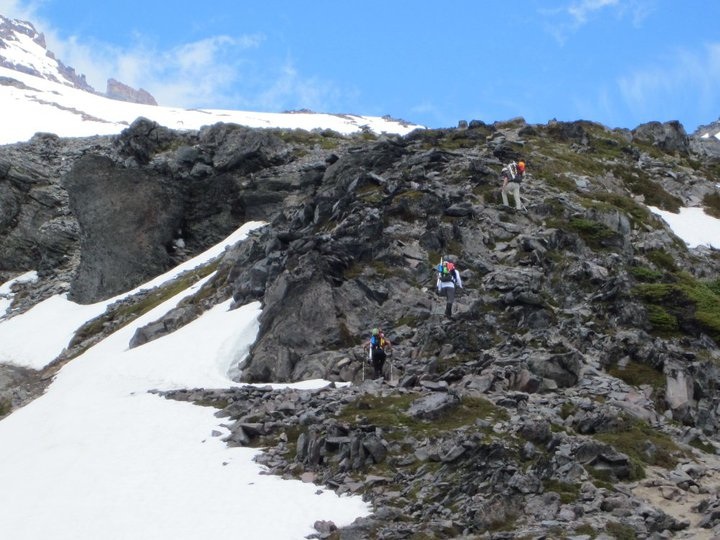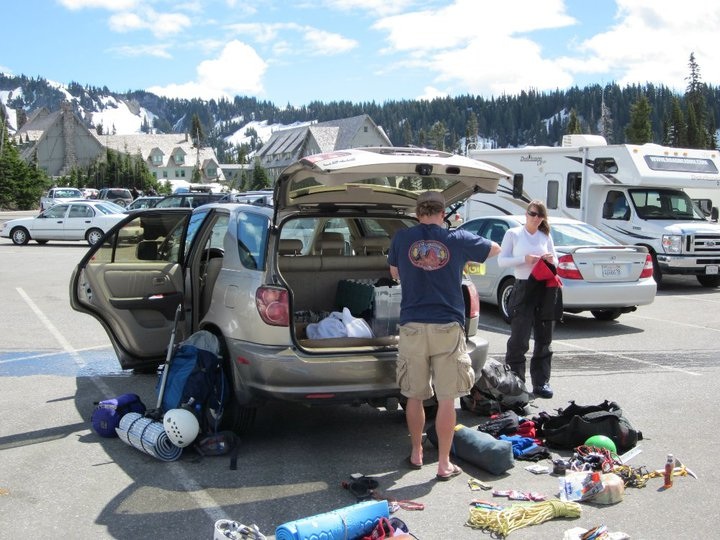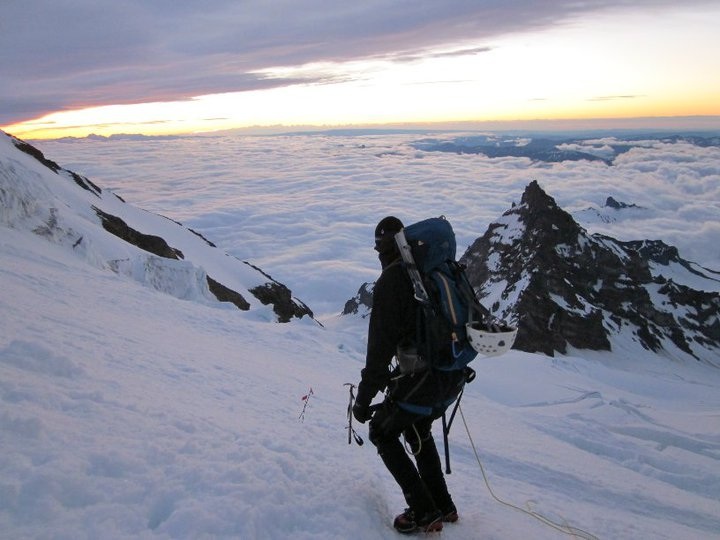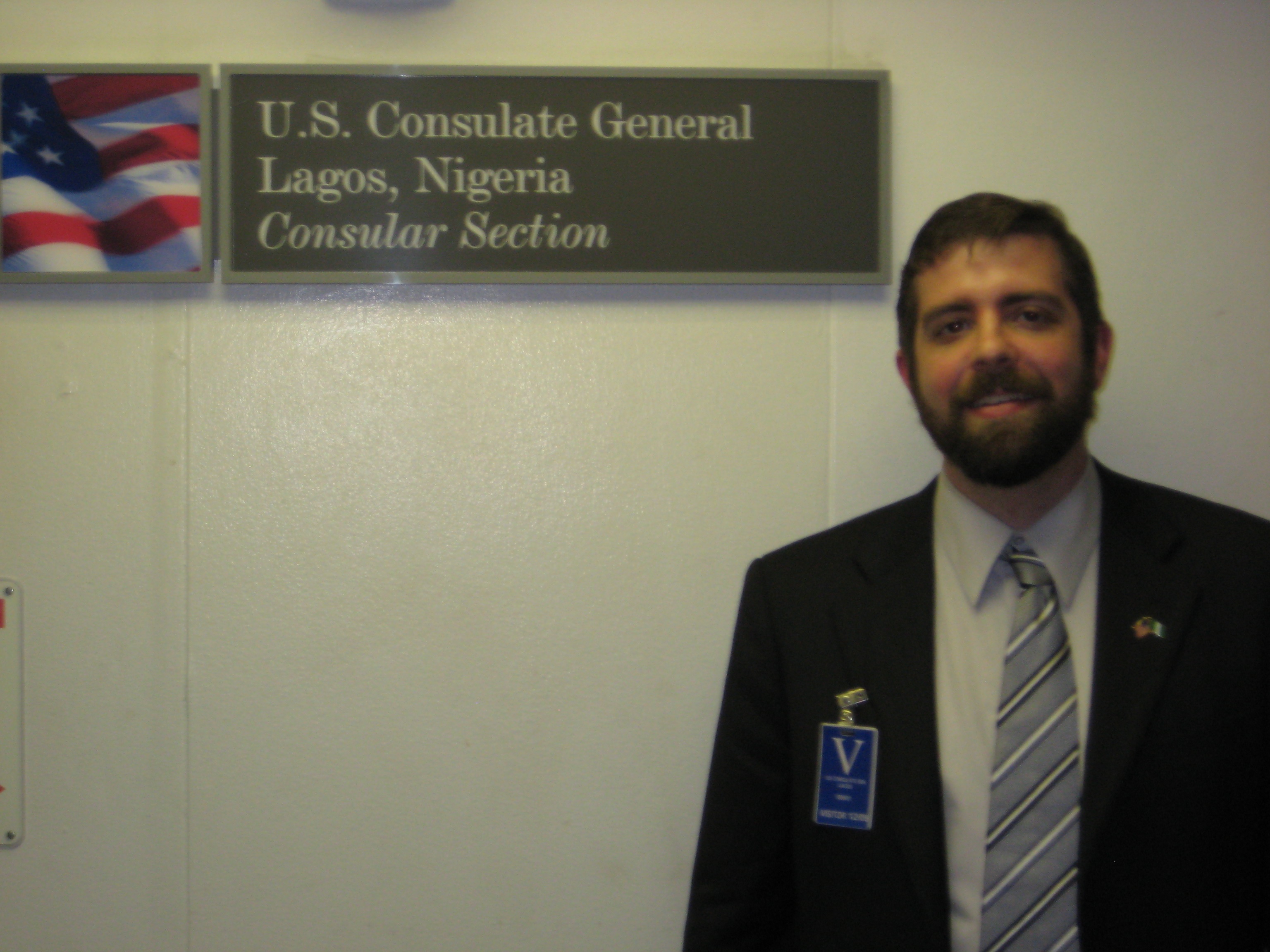


| Main | Spotlight on IAS | Alumni Features | Alumni Shorts | Faculty Reports | From The Top | Important Links |
|---|
Alumnus Travels World as Vice Consul

by Galen Annest
Recent IAS Alum Galen Annest chose a rather unique way to celebrate graduation. Following is her recounting of that experience.
I want to apologize in advance for the informal tone. You are about to read my private thoughts…actually, written at the time I thought them. It appears to me now as I read them, that my thoughts tend to be somewhat unceremonious. But before I get too intimate, allow me to give you a bit of personal background and explain why I ended up writing a narrative about my experience of trying to climb Mount Rainier.
Like you (or least likely someone you know), I am an alumnus of the University of Washington Tacoma’s Interdisciplinary Arts and Sciences (IAS) program. I chose to study communication at UWT, and as a result of that choice, learned that I love writing. After finding a niche in public relations -- thanks to the encouragement of a great professor -- I spent the rest of my college years developing my writing and media skills.
There was an element of the college experience, for me, at least, that drove me push myself hard, to expand every capability, and I enjoyed it. I enjoyed it so much, in fact, that I started applying it to all aspects of my life, including physical training. My first big run was the Seattle Marathon during my junior year, and I have since done several half marathons in Tacoma, Portland, and Manhattan. Long distance running fortified my intellectual achievements and vise versa. As graduation snuck up on me, I realized that I wanted to mark the accomplishment with something just as amazing physically.
So, my graduation gift to myself would be to summit Mount Rainier. Luckily, I was asked to assist with the IAS alumni newsletter, and felt a step-by-step description of my upcoming climb would be the perfect subject matter. You may have climbed the Mountain, maybe you will someday, or maybe you won’t, but right now, I now get to take you along on this journey using writing, a craft I hope I have developed through my time at UWT. (And, as I have learned, one must never pass up the opportunity to shamelessly promote oneself).
That’s enough background. You’ll pick up the rest during the climb. I sincerely hope that my account of this adventure will convey even a tenth of what it was really like to be there. So, let me take you to the parking lot at Paradise in Mt. Rainier National Park, elevation 5,400 feet, and the start of both the ascent and the story.

Galen and Jon preparing for the climb
Monday, June 28, 10:30 a.m. -- We are ready. We got
a late start from Tacoma but the weather looks decent and the mountain
is beautiful. I am not sure what to expect at this point but I’m
excited to find out. I am climbing with two of my really good friends
Jon (our guide) and Thomas. Both guys are in incredible shape. Jon is
ruggedly handsome with the type of tan that you can’t earn at sea
level, and a smile so wide and white that my eyes constantly skip from
his mouth to his magazine quality frame. His quiet authority on the
mountain puts me at ease.
Thomas stands so tall that he would
command attention even if he did not resemble a Calvin Klein ad, and to
top this, he is the perfect balance of personality and ego. Thomas and
I first met when he was bartending at The Matador on Pacific Avenue.
Every bar stool was occupied by a female obviously there for more than
just quenching their thirst. Jon and Thomas are both alpha males, and
they never stop competing—it is entertaining to say the least.
As I sit in the drivers seat writing this with the steering wheel as my
desk, they are outside scrambling to get our gear ready. Thomas is
rolling up our sleeping pads and cramming our down sleeping bags into
stuff sacks that are so small they don’t look as though they could hold
a child’s coat. Jon is meticulously checking the 150-foot climbing rope
and the harnesses that will anchor us to it on the trip from base camp
to the summit. I have packed the food and triple checked the gear list:
crampons-check, snacks-check, clothes-check, Camelback-check
(repeat). Everything is set. It is time for me to put on my
60-pound pack and start the four-mile hike to Camp Muir (base camp) at
10,236 feet. I’m not sure if it is the caffeine or the nerves but I’m
jittery and my stomach is in knots.
Monday, 1 p.m. -- I am half way to Muir and I want to quit. My pack weighs almost half of my body weight and keeping up with these guys is near impossible -- and I am in shape. As though to test me further, the wind is blowing so hard that I am digging my poles in the snow to stay upright. I would kill for my iPod right now. The scenery is beautiful. As I sit on a rock that is more comfortable at this point than any couch, I can see the summit through wisps of clouds. They are dancing around my destination like angels playing ring around the rosy. Crisp mountain air smells better than any laundry detergent claiming to have bottled the scent, and the soft snow under my boots is like walking on cotton; I keep reminding myself of these wondrous things as I force one foot in front of the other. I am making myself go 20 steps without stopping to rest. Each time is harder. Maybe I will reduce it to 15…

Base Camp Muir, a climbers station 5,400 feet above sea level
Monday, 5 p.m. -- I made it to base camp. I don’t know how, but I’m here. My shoulders feel like I gave an elephant a piggyback ride, but setting my pack down was one of the best feelings I have ever had. Our trio is in good spirits. We have set the tent up and I am in my warm sleeping bag while the guys are melting snow on their stoves for our summit trip to replace the water that we drank on the way up to Muir. The outhouse up here is so foul it makes me gag, and the smell sticks to my clothes. We will stay here for the next several hours and try to get some sleep before we head up the mountain at 1 a.m. We are all eating whatever we can find in our huge packs: gummy bears, pepperoni sticks, goldfish, and cheese. We are cracking jokes about the other climbers, which is something I think we all silently know keeps our mind off the cold and the upcoming climb.
Monday 9 p.m. -- I can’t sleep. The sun has just
gone down and the moon is close to full. We are up high, and when I
look out of my tent the cloud line is so far below me that it looks
like the ocean. I am playing out different scenarios for the climb, but
I am so unsure of how it will go that I keep imagining every
possibility. What if I can’t make it? What if someone falls? What if
they die? What if I have to choose between Thomas and Jon? What if they
have to choose between me and the other person?
What if I die?
Perhaps it sounds dramatic to you, but as soon as I set foot above the
clouds I realized just how easily the fatigue and altitude could hinder
decision-making. I need to slow my mind down. Deep inhale… ok,
now exhale, and try to sleep.
I can’t believe that in a few hours I will push myself even
further. I wonder if Thomas is going through the same emotions; it is
his first time as well. Jon is snoring quietly next to me. Maybe I
should have had some of the guys’ whiskey that they packed in?
Tuesday, 1 a.m. -- I am not sure if I slept or not. I was in that weird spot between dreams and consciousness and I still feel tired. All three of us are bantering easily with one another, and the excitement is so high that it wraps around me like a blanket. Our gear is ready. I can see the first group of people that just left camp, their headlamps illuminating small circles of the snow. This place is unreal. I feel like I exist in a completely separate world. The stars seem different, brighter? The mood is somber and stoic, and the energy here is what I would imagine soldiers feel like before battle.

Thomas enjoys the sunrise from a vantage point above the clouds
Tuesday, 4:30 a.m. -- We are taking a break at 12,000 feet before we trudge up the Upper Ingram Glacier. We have covered 1,764 vertical feet and we still have 2,415 feet to go. This is the most surreal place I have ever seen. The sun is starting to rise. I had to stop to take it in. It is so beautiful that there are not enough superlatives to describe it properly. If it is true that the most memorable moments flash before your eyes when you leave this life, then this sunrise will be one of mine.
Tuesday, 6:30 a.m. -- My hands are so cold I can
hardly wrap them around my ice axe, and the weather has turned into
raging winds and snow. I have pushed myself beyond my limits and I am
still going. We are taking a short break after crossing a crevasse. The
crevasse was like something from a nightmare. It was more than six feet
wide and the only way to get across was to walk over the murky blue
depths on a metal ladder. I kept reminding myself not to look down as
my metal crampons connected with the ladder to make a sound reminiscent
of a head on collision at 60 mph. My fear of heights and the altitude
elevated my pulse to a level I have never reached in my 17 years of
working out. Each step lasted an eternity. I am quite certain I aged 15
years in the five minutes it took to cross.
I am miserable,
tired, cold, and irritated. Both Jon and Thomas are quiet. Thomas feels
sick from the altitude, and my thoughts are getting weird from the lack
of oxygen. I want to untie my rope. It is necessary to tie up to
one another for this type of climb because of the possibility of a
crevasse fall or slipping down the steep slopes. I am in the middle of
the guys and they are constantly pulling or pushing me at different
speeds. I have used every swear word in my vocabulary, and am passing
the time by trying to come up with new ones. They are telling me I need
to eat, but the altitude makes it difficult. I never want to see
another gummy bear in my life.
Tuesday 7:45 a.m. -- Jon is talking to another rope team that has turned around. We are stopped at 13,600 feet (800 vertical feet from the summit), and I can see glimpses of it through the clouds and snow. The wind is gusting at 70 mph and the snow feels like needles on my face. I have to dig my ice axe in when the wind hits, and I am afraid that I am too tired to self-arrest (stop myself with my ice axe) if it pushes me over. I keep thinking about the sunrise and how amazing it is to be up here -- it’s not helping. I can see glimpses of my summit through the wind and snow and
Tuesday 8 a.m. -- I had to warm up my hands; they were so cold my writing was illegible. Jon is turning us around. He thinks the wind is too dangerous and other climbers are turning around as well. There are tears falling from my eyes as I write this, not because we are turning around but because I am overwhelmed with fear, anxiety, anticipation, determination, and misery. I can’t stop the emotional rollercoaster. Perhaps it is better this way because if I could I would call it quits and die up here. I will not let the guys see me cry. Thank God the wind and snow make it impossible for them to tell.

Tuesday 10:30 a.m. -- None of us spoke on the way down. We are back at Muir and that bathroom almost smelled good after what I went through. I imagine that the guys are wrestling with their own emotions of disappointment, fatigue, self-doubt, and relief that it is almost over. We are packing up camp and I am praying that my pack will feel lighter with some of the food and water gone. I am too tired to write more.
Tuesday 4 p.m. -- I am writing this from the heated
seat of my car. It is over. I cannot believe that it has only been a
day and a half since we started. It feels like a lifetime. I thought
that I had trained for this trip, but I realize now that there is no
way to prepare for something like that. The mountain is in the rearview
mirror, and looking at it makes me think about the other mountains in
my life. I started this climb to get to the top. Looking at it now, I
realize that if I had made it to the peak, I would never go back.
Everyone has a summit. Sometimes they are reachable, and sometimes you
turn around when they are inches away. I have learned more about who I
am in the last two days than I thought possible. No matter what your
mountain looks like, or how high your summit may be, climb until you
reach it.

IAS Alumnus Ryan Long is currently serving a two year tour as Vice Consul to U.S. Consulate General in Lagos, Nigeria
By Kimberly Wynn
Growing up,
Ryan Long dreamed of becoming an airplane pilot while picking
blackberries by Mount Rainier. As a 33-year-old newly married man
with a miniature dachshund named Maeby, Long’s blackberry picking days
are well over, but he has had the opportunity to travel the world as a
vice-consular.
Long
graduated from Amador Valley High School in Pleasanton, Calif., and
then moved with his mother to join his father in Federal Way,
Wash. He did not have his sights set on a four-year university
because his grade point average was less than satisfactory and he did
not try his luck with standardized testing either.
In fifth grade Long was diagnosed with a learning disability, but he did not wallow in self-pity. He went to Highline Community College part time, graduated in four years while working at America West Airlines, and then attended a college fair where he learned about the then young University of Washington Tacoma.
“I
got really interested in the Interdisciplinary Arts and Sciences
program,” Long said. “After reading about it, I made up my mind
and applied for a transfer without applying to any other schools.”
It
was’t until Long graduated from UWT that he began to think about
starting a career with the state department. According to Long,
he owes his decision to further investigate a state department career
to his professors and courses at UWT.
“My
experience in a class with Dr. Jim Gawel was what inspired me to minor
in environmental studies and tackle subject matters that were much more
challenging to me,” Long said. Professors Yonn Dierwechter and
Anthony D'Costa both gave me a good introduction to globalization and
geopolitics that motivated me to pursue a Master's in International
Relations. ”
While
at UWT, Long cut his hours to half-time at America West Airlines in
order to be a full-time student. He absolutely loved the location
of UWT being in downtown Tacoma.
“The
campus is very close to the Port of Tacoma and there is a lot of
commerce going on right at UWT's doorstep,” Long said. “If I were
still living in the Seattle area I would be quite happy living in
Tacoma and the area around the UWT campus. I miss Rock Pasta, the
Harmon Brewery, and The Swiss. It was nice to go to The Swiss or
the Harmon and decompress over a pitcher after an exam.”
Long
has been stationed in Lagos, Nigeria, for a year-and-a-half as a
vice-consular. He has worked in both the non-immigrant and the
immigrant visa units of the consular section. Lagos is the
busiest visa processing post for the state department in sub-Saharan
Africa, according to Long.
“While
working in the non-immigrant visa section, I typically interviewed 60
to 90 applicants in a day, often spending two or three minutes with
each individual applicant and longer with families,” Long said.
“During that time, I had to make a determination on whether the
applicant(s) qualified for the visa based on U.S. immigration laws.”
Long
has thoroughly enjoyed working with his colleagues, managers, and the
Nigerian people. The Nigerian staff is great and they provide the
institutional knowledge that is necessary for the operation of the
section since the entire American staff will turn over every three to
four years, according to Long.
“I
already have my next assignment. I'll be going to Buenos Aires,
Argentina, for a two-year tour in fall of 2011,” Long said. “I’m
extremely excited about this position because it combines my interests
in international relations and environmental science. I’ll definitely
be relying on teachings from UWT in that job."
By Todd Schlaudraff
When something matters enough to you, you want to be able to invest in it, and as an alum of the University of Washington Tacoma, you might be ready to make that commitment, but are unsure how to begin. Here are some quick steps to get you started.